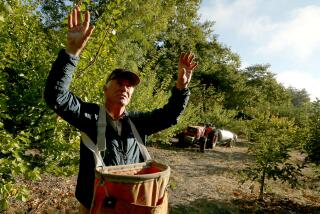Preeminent in His Field, Victor Voth Has Sown His Seeds Worldwide and Shares the Fruits of Knowledge of . . . : The Strawberry Man
- Share via
IRVINE — When Victor Voth speaks, the strawberry industry listens.
It is that way the world over because Voth, 71, is the acknowledged guru of strawberries. During his 40 years studying the tasty fruit at the University of California South Coast Research and Extension Center in Irvine, Voth has developed more than 20 different marketable strains.
“When you go to a supermarket and buy strawberries for your family, they are undoubtedly from a strain developed by Voth,” said Bob Bevacqua, the field station superintendent. “The same can be said all over the world. The industry has basically followed his lead.”
Voth, pomologist and impromptu philosopher, held court Wednesday morning at the field station’s Strawberry Field Day. For the 40th time in his career, Voth offered his strawberry expertise at the station’s open house before about 100 strawberry growers, researchers and horticulturists, and even a sprinkling of laymen seeking only simple tips on their jams and preserves.
The Southern California strawberry industry in particular owes much of its life to Voth. In 1952, when Voth began serious work on strawberries in this area, only 10% of the California strawberry industry, the world’s largest, was found south of Oxnard.
“By the 1970s, thanks to the techniques discovered by Voth, over 60% of California strawberry production comes from Southern California,” Bevacqua said. Today, the strawberry is the No. 2 crop in Orange County’s $250-million annual agricultural industry, making up about $35 million in annual sales, according to the Orange County Farm Bureau.
Voth, whose face has the tawny, lined look of someone who spends his day outdoors, attributes the success of Orange County strawberry growers to the climate. For strawberries, it is unmatched in the world, he said.
“I’ve traveled all over . . . to Spain, both sides of Gibraltar, to Italy, Israel, Chile and Colombia, but in all my travels I have never found anything like this climate,” Voth said. “They say it’s a Mediterranean climate, but it’s unique.”
Though most Orange County farmers plant seedlings that have been started and imported from other parts of the state, the growth of the fruit thrives during temperatures between 55 and 75 degrees and “Orange County has the most days between those temperatures.”
“As soon as it gets up into the high 70s, the fruit is finished,” Voth said. “It’s all temperature.”
Unlike many in the crowd Wednesday, Voth has no postgraduate degree, only a bachelor’s degree from UC Davis. Anyway, he didn’t learn about plants from books, he said.
“Everything I’ve learned, I learned from the plant itself,” said the San Clemente resident. Voth, who grew up on a farm in the San Joaquin Valley, has worked almost his entire career at the field station, which is the foothills east of Irvine.
His specialty in strawberries was never intended to last, he said in an interview.
“I didn’t find the strawberry, the strawberry found me,” he said. “I’m a frustrated farmer. I went to work for the university for a few years just to get back on the farm. I’m still here.”
Voth likens himself to “Sherlock Holmes,” observing, checking for clues and ever on the lookout for a new breed or new hybrid of the strawberry, which, like the apple, nectarine and pear, is actually a member of the rose family. “The blooms are where the similarities lie,” Voth said. “That’s where it all starts, in the flowering parts.”
Despite the climate, strawberry growers must prod people like Voth for new, more productive varieties because it is such an expensive fruit to produce, said Teresa Thorne of the California Strawberry Advisory Board, who was among the group shuttled across the 200-acre research center to Voth’s five-acre strawberry laboratory.
Because of land and water costs and the fact that strawberries are so labor-intensive--strawberry growers estimate a cost of $11,000 an acre before even one berry gets picked, contrasted with $50 an acre for corn--it’s essential to keep developing new, more productive strains.
That expense keeps Voth at work, experimenting with such things as drip irrigation, which he revolutionized at the field station, and new strawberry breeds.
More to Read
Sign up for Essential California
The most important California stories and recommendations in your inbox every morning.
You may occasionally receive promotional content from the Los Angeles Times.













